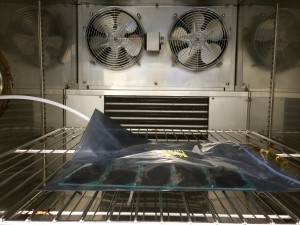Solar Panel Thermal Test
 We now know that our solar cells won’t slide off at extreme temperatures. We put our body fixed solar panel in an ESD bag with a nitrogen purge to prevent any water condensing and freezing while we ran the test. Then we stuck it in one of LASP’s giant thermal cyclers and ran the solar panels up to +120ºC and down to -60ºC. Our solar cells are attached using double-sided Kapton tape and silver epoxy. Both of those seem to have survived the thermal cycle quite well. Those weren’t random temperatures either: they are the extremes that we may see on orbit based on Thermal Desktop modeling and prior flight experience. It’s good news! Everything checks out. Tomorrow we’ll be building up the next flight body-fixed solar panel.
We now know that our solar cells won’t slide off at extreme temperatures. We put our body fixed solar panel in an ESD bag with a nitrogen purge to prevent any water condensing and freezing while we ran the test. Then we stuck it in one of LASP’s giant thermal cyclers and ran the solar panels up to +120ºC and down to -60ºC. Our solar cells are attached using double-sided Kapton tape and silver epoxy. Both of those seem to have survived the thermal cycle quite well. Those weren’t random temperatures either: they are the extremes that we may see on orbit based on Thermal Desktop modeling and prior flight experience. It’s good news! Everything checks out. Tomorrow we’ll be building up the next flight body-fixed solar panel.
